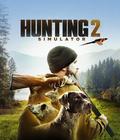For a number of traditional hunting game fans, theHunter: Call of the Wild is considered to be the pinnacle of the somewhat-niche genre. From the vast open lands to the tracking system to the number of tools at your disposal, the game has become the go-to title for those who want to go hunting solo or with friends. This hasn't stopped others from attempting their own takes on the category, such as Neopica's Hunting Simulator a few years ago. While the end result wasn't great, it is nice to see the developer give it another shot with Hunting Simulator 2, and we recently took a look at a preview build.
The preview build gave us access to two settings in Colorado. Roosevelt Forest is perhaps the more traditional setting; you get a dense forest, a long river bank, and a few open fields here and there. Since this is one place that houses every single animal in the game you can hunt, expect to get to know it better over time. Pawnee Meadows, on the other hand, is an open plain with animals hiding behind a few hills. The clearing makes for a nice change of pace compared to other hunting games.
Based on this build, there are quite a number of additions and changes since the original. One of the more notable ones is the fact that you can now hunt with a dog by your side, something rarely seen in other games in the genre. The preview build had access to a beagle and, as expected in a hunting game, you can use the dog to sniff out animal scents and other markers, such as droppings and eaten food, to get a better sense of the prey's location.
At the moment, however, the dog behavior is such that you might use him to catch your initial lead on an animal only to ignore him immediately afterwards. Your dog can find trails, sniff out markers, and find clues. The idea is to constantly train your dog to get better at tracking, but be prepared to do most of the work in this regard, especially when your dog simply wanders around with no indication that he's just lost.
Another big change can be seen more as regression, since you no longer have access to many of the tools available to you in the first game. To be clear, you still have four different weapon types to choose from, and your gear can consist of binoculars that give you more accurate distance readings as well as tools to indicate wind direction. Don't expect to get readouts of the exact location of your prey, since things like drones are completely absent now.
The removal of things like that and flourishes like a bullet cam or a slow-motion camera once the gun is fired can result in a sure hit makes the game feel more straightforward. In a way, Hunting Simulator 2 is reminiscent of the old Cabela titles from over a decade ago, only with more slow periods of walking and waiting and a more relaxed stance on shooting, since things like wind direction and bullet drop still don't factor into any of your shots. Some critics might opine that this isn't enough to live up to the game's "simulation" moniker, but compared to the original, it's a start.
Another interesting change from the original has to do with multiplayer, which is now gone. It's a curious move since the previous game's online play was quite solid, and group hunting brings forth a different dynamic than going solo. As evidenced by theHunter, the audience is still there for multiplayer hunting parties, and many critics of the original still enjoy that feature, so its removal is something of a head-scratcher.
All of this places Hunting Simulator 2 in an interesting position. The idea of paring back the tools from the first title does a good job of making the hunt all about your tracking skills and instincts. The inclusion of a dog is a great idea and the environments show promise, but the omission of multiplayer seems like an odd choice. We'll see how this all shakes out when Hunting Simulator 2 hits virtual store shelves in late June.
More articles about Hunting Simulator 2











 Environments, animals and official gear, Hunting Simulator 2 leaves nothing out in providing a full and enthralling hunting experience.
Environments, animals and official gear, Hunting Simulator 2 leaves nothing out in providing a full and enthralling hunting experience.







